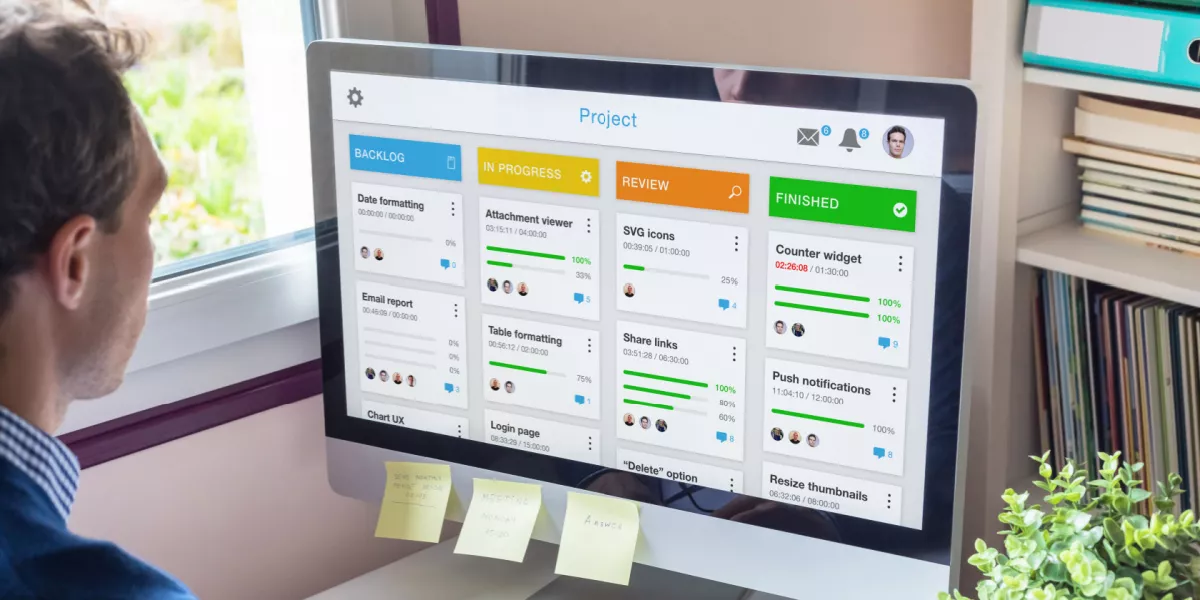How to improve staff retention with technology

When a team member exits your business, it can leave a noticeable hole. But when large volumes of your workforce are departing, the problems can be much more serious.
High staff turnover can lead to inefficiencies, lost expertise, significant time spent in hiring and training, dampened morale and lower productivity. It can also be indicative of general dissatisfaction within your business.
But there are solutions at hand. In this article, we'll explore how technology can play a role in employee retention, wellbeing and decision-making.
We'll also share some tech strategies your business can adopt to help keep staff engaged and content, as well as some examples of where it's worked across industries from construction to eCommerce.
What is staff retention, and why is it important?
Staff retention refers to an organisation's ability to keep staff members on board - that is, the number of employees who are happy in their roles, and not looking for work elsewhere.
It's often seen as the measure of a company's culture and job satisfaction. A low turnover suggests strong culture and a workplace people genuinely enjoy being a part of.
But there is also a correlation between staff retention and business success. As identified in a recent study by the University of Warwick Department of Economics, happy employees are more productive; they feel valued and appreciated, so they're more likely to go the extra mile to hit a deadline or complete a difficult task.
Employees who work together for long periods of time form bonds and friendships, and are more likely to perform as a well-oiled machine. They also hold 'institutional memory' - they know all the ins and outs of their roles, and can tackle most situations quickly and efficiently
On the other hand, high turnover can have a negative effect on morale. If roles aren't filled quickly, this is exacerbated by increased workloads for those who remain.
Losing long-term employees can mean losing deep knowledge of the business. Training new employees takes time, while also taking other employees away from their day-to-day duties.
Hiring can also be an expensive process, with recruiters generally charging a percentage of a new hire's salary.
Trying to keep staff happy is the right thing to do - it's treating people respectfully, promoting fair working conditions and fair pay; showing people they're valued and respected at work.
But on top of all that, it's just good business sense.
Technology drives employee decision-making
What is abundantly clear is that there is a direct correlation between having access to proper technology and job satisfaction. In fact, in a survey of 10,000 office workers from around the world by software and IT services business Ivanti, almost half (49%) said they were frustrated with the technology provided by their employer.
What's more, 26% said they would consider quitting because of it while more than 40% said they have spent their own money on tech products, to make their jobs easier.
In Australia, 70% of respondents said their digital working experience – and the way they interact with technology – had an impact on their work morale.
At the same time, decision-makers don't seem to acknowledge the problem. Only 21% of leaders said they prioritise usability when choosing tech products, while 62% of IT decision-makers said they prioritise revenue over employee experience.
But revenue and employee experience are linked. Businesses that focus on positive employee experiences are thought to be up to four times more profitable than those that don't, according to PWC. Yet, they're typically 25% smaller, meaning they're more productive and more efficient.
Employee morale leads to better engagement and less staff turnover. That means better productivity, less time wasted, and ultimately better profit margins.
With the modern work environment having such a strong reliance on technology, providing employees with the proper tools and a positive digital experience can be a defining factor in establishing a positive company culture and strong employee morale.
What makes a good workplace technology experience?
The right technology in the workplace empowers employees to communicate effectively, focus on their tasks, and play to their strengths. It enables them to do what they do best, to the best of their ability. That goes for both remote and on-site workers.
For remote workers, technology is integral to communication and teamwork. In a traditional office, everyone has a desktop setup or a laptop, not to mention printing and scanning needs or phone connectivity.
In warehouses, retail stores and services-based businesses, employees will use booking systems, thermal label printers, barcode scanners and inventory management tech daily. Of course, almost every workplace also requires an internet connection.
We've all experienced the frustration of tech that's slow, hard to use, or just doesn't work.
Technology should make life easier; make everything run smoothly, quickly and efficiently, without requiring extra effort.
When it does the opposite - when it actively gets in the way - there is nothing more infuriating.
Investing in technology to improve employee retention doesn't necessarily have to mean investing in the most expensive, cutting-edge pieces of kit available.
It can be as easy as updating software or making sure everyone's laptops are running smoothly. Or, it could mean implementing a few key tools to help people do their jobs while removing any roadblocks in the way.
Employers can also use tech to monitor worker wellbeing, remove manual or repetitive tasks, and free up time for employees to focus on their core responsibilities.
It may be the case that a few tech tweaks can make a huge difference to employee experience, and therefore improve staff retention throughout the organisation.
Technology tips for staff retention
There are several ways employers can use technology to help support staff retention. And while not every solution will work for every business, these might give you some ideas for getting started.
Don't let ageing tech hold you back
This may seem obvious, but make sure the equipment your employees need to do their jobs is up to scratch. A computer that's running slowly, for example, can impede someone’s ability to do their job well and lead to serious frustration.
Or in the case of warehousing, if a product or barcode scanner isn't working properly 100% of the time, that could lower productivity, or even lead to inaccurate inventory reports.
In many cases, investing in new or improved tech will cost less than the productivity losses.
Many businesses are also relying on outdated back-end systems, which can be costly to maintain and can hold them back from embracing more efficient ways of working.
If it makes sense for your business, consider a shift to cloud-based digital processes, powered by data and maybe even artificial intelligence.
Bring in the experts
When it comes to managing technology, there are some jobs that just need to be done, but don't fall under the remit of anyone in particular. In this instance, consider bringing in outside help, allowing your team members to focus on their core responsibilities.
For example, Brother offers a Managed Print Services (MPS) solution, whereby a third party manages your organisation's printing and document operations.
This includes everything from providing the printers or Multi-Function Centres (MFCs) themselves, maintenance, support, and refreshing toner and ink, as well as data analytics, helping MPS providers to tailor services over time.
An MPS program can also allow for better workflow management and automation, removing bottlenecks in your printing ecosystem. Brother’s MPS solutions are also tailored to meet individual business needs, meaning they work for both office-based and hybrid organisations.
Instead of wasting time in printing queues or waiting for printers to be repaired, employees will be able to make use of a seamless printing service, while remaining focused on the things they're best at.
Assess engagement and culture
You can't start to improve employee experience if you don't have a sense of how your staff are feeling, and there are a range of tools available for understanding sentiment among employees.
Australian startup Culture Amp, for example, offers employee engagement, performance and development tools. It then delivers data and insights, including forecasting which teams could be at risk of employees leaving.
Elsewhere, Teamgage offers engagement tools for individual teams, supporting leaders and empowering them to support their team members in turn.
According to Teamgage, its customers typically experience a 24% reduction in turnover after implementing the platform.
Foster seamless connections
According to the Ivanti research, 87% of employees would prefer to work either partly or fully remotely. That means being able to connect digitally - and using the right tools to do so - is more important than ever.
Platforms like Zoom, Microsoft Teams, or Google Meet offer solutions for video meetings, while tools such as Slack offer a more 'chatty' experience for employees to communicate.
Some businesses implement individual Slack channels for teams or projects, plus channels for sharing social or casual content. This can help employees to stay across key developments, while also allowing for employee bonding.
Use tech to recognise and reward
Recognising and rewarding excellent work is a great way to show employees they're appreciated, thereby boosting morale and motivation. And there are various tech tools available to help.
Australian HR platform ELMO, for example, offers an engagement and rewards solution, allowing employers to allocate awards and custom digital trophies, which employees can display.
Staff members can also celebrate their peers, giving online 'badges' for contributions that live up to company values.
Provide a safe working environment
Providing a safe working environment requires more than just tech hardware. Digital tools and software can be part of the strategy.
MindTribes founder Div Pillay has launched the #NotMe App in Australia, a platform allowing employees to anonymously report misconduct and discrimination in the workplace.
Teamgage has also partnered with the University of South Australia on a product identifying risks of bullying and harassment in the workplace, helping employers to stop bad behaviour before it starts.
Create professional development opportunities
Another way to keep employees engaged, motivated and feeling valued is through upskilling. Learning opportunities can help employees advance within your business, or simply empower them to do their job better - while feeling great about it.
The Hays Salary Guide found that 60% of employees consider learning and development to be important to their careers. However, only 18% of employers consider upskilling as a key strategy.
This suggests that offering professional development opportunities could help give your business the edge in attracting and retaining employees.
Australian startup Go1 helps small businesses and startups by providing learning opportunities to employees, tailoring content to the organisation in terms of scale, branding and subject matter.
Automate tedious tasks
Research from UiPath in 2022, as reported in IT Brief Australia, found 52% of surveyed employees feel their workday is 'eaten up' by tasks that could be automated.
In Australia, 61% of respondents said automation would save them time; 52% said it would increase productivity; and 67% said it would allow them to focus on more creative tasks.
In many industries, there are software and automation tools that could assist with tedious or repetitive tasks, freeing up employees to focus on the work they find more rewarding.
In retail, for example, New Zealand-based Unleashed Software allows for easy inventory and stock management, as well as integration with various eCommerce streams.
That can allow eCommerce owners and employees of smaller retail businesses to focus on things they're passionate about, such as creating or sourcing products and providing stellar customer service.
Many of these automation tools rely on the use of artificial intelligence (AI). For more examples and information, read our guide on how AI can benefit both businesses and remote workers.
Ensure smooth onboarding
If you want your employees to be happy and engaged at your organisation, it's important to get off on the right foot. And while good onboarding usually requires some face-to-face time, there are tools that can help the process go as smoothly as possible.
Australian startup Pyn offers automated onboarding, serving up relevant communications and peer-to-peer support as new hires progress through their first day, week and beyond.
It also allows employers to deliver personalised communications at key moments in every employee's career, improving engagement and retention in the long run.
Case studies of successful staff retention strategies
Improving staff retention with technology doesn't mean implementing all of the above strategies. Businesses also don't necessarily have to invest heavily or reinvent the wheel.
For many businesses, making a small change or onboarding one new tech tool, can make a huge difference.
Here are three examples of Australian businesses that have done just that.
Koala
Koala is an Australian mattress and furniture eCommerce retailer, which now also has teams in the US, Japan, Brazil and Korea.
In 2020, the business went through a period of very fast growth, which saw its workforce almost double. At the same time, however, it was experiencing high employee turnover.
Koala utilised Pyn's platform to improve its onboarding and communications processes and to learn about new employees' experiences.
The data showed that the first few months of an employee's journey were 'make or break', so the team implemented an online buddy system, to help support them.
In a case study, Koala's global director for people and culture Netta Efron said: "The ability to personalise employee communications using the content in Pyn is something that is going to be crucial to how we're able to retain employees."
Employment Hero
As detailed in an IT News article, HR and payroll platform Employment Hero leans into Slack for its internal communications, encouraging employees to use custom emojis, social channels and channels for business units and professional development.
The business has adopted Slack as its main communication platform, favouring it over email.
It's also embraced integrations with the likes of Asana, to encourage smooth workflows, and G2, so that positive customer reviews are shared automatically.
"This really helps us to foster a culture of celebration and recognition," Employment Hero customer marketing manager Rosie Mitchener said.
Slack also allows for engagement with the leadership team.
"Even the newest employees have the opportunity to chat with the CEO and leadership team, getting to know them on a personal level," Michener said,
"It's fun, it's laid back, and we find this kind of levelling of the playing field makes Slack a really valuable tool."
Richard Crookes Constructions
Finally, family-owned construction company Richard Crookes Constructions (RCC) had been using Culture Amp's engagement tools for an annual 'pulse check' since 2016. But a period of growth meant it needed something more to maintain its 'family' culture and strong client focus.
RCC's HR business partner Nancy Fedele worked closely with Culture Amp to shift to quarterly engagement surveys, implement the 1-on-1 tool to help managers communicate with team members, and to offer access to skills coaching, training opportunities and other resources.
The strategy increased employee engagement from 79% to 89%, and typically about 90% of employees now say they're proud to work at RCC.
In an industry that's notorious for high workload, high turnover, and little focus on employee wellbeing, Nancy is proud of those results.
"[Employees] see we are listening and making an effort to highlight and promote what our employees need and enjoy. People make the connection that their voice is heard."
Empowered teams build powerful businesses
Whether it's implementing a new workflow tool or embracing a managed print services provider, there are many ways businesses of all shapes and sizes can implement technology to make their employees' lives easier.
Staff members will stick around if they feel valued, motivated, seen and heard; and if they feel empowered to do their job well and efficiently, using technology that enhances productivity.
It's not always about cutting-edge tech. It's about supporting employees to do their best work. Give them the tools they need, and give them your trust - and they'll help your business to fly.
When it comes to printing and scanning, or labelling technology, Brother are experts, providing a broad range of products and services to keep your business moving and your employees satisfied.
To learn more about what technologies Brother can help you introduce into your workplace, contact us today. Or alternatively, book a free print assessment.

Resource Library
Be the first to receive exclusive offers and the latest news on our products and services directly in your inbox












.jpg?h=720&iar=0&w=1920&rev=36358aeeea934b07bce65a5d230d3519)